Home > Highlighting JAPAN > Highlighting Japan OCTOBER 2012 > Architectural Regeneration
Highlighting JAPAN
COVER STORY: TOKYO: NEW PERSPECTIVES
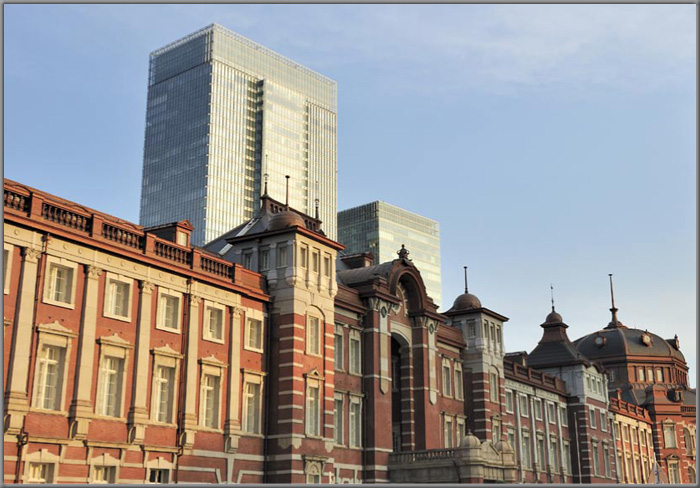
Caption: The restored Tokyo Station Marunouchi Building. The building stands about 46.1 meters tall at the highest point, and total floor space is about 43,000 square meters.
Credit: KAZUE HASHIZUME
Architectural Regeneration
Tokyo has developed through three ages in Japan's long history: early modern times beginning with the Edo period (1603–1867), modern times beginning with the Meiji period (1868–1912), and contemporary times. This history is reflected in aspects of the city's architecture, and in the case of some buildings, almost all at once. Toshio Matsubara reports.
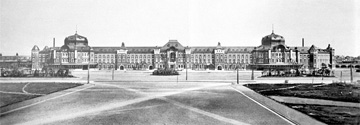
Tokyo Station in 1914, immediately after its completion
The Tokyo Station Marunouchi Building, which was built in 1914, is a resplendent, Victorian-style red-brick building with a regal air. It is said to be the greatest work of architect Kingo Tatsuno. The three-story, 350-meter-long station building is centered on the entrance in the middle, with its design extending symmetrically to the right and left and domed roofs on either end. The building, which has a symbolic presence in Japan's modern architecture, has been designated as an important cultural asset.
Tokyo Station was built extremely sturdily and thus did not sustain much damage in 1923 at the time of the Great Kanto Earthquake. During World War II, the uppermost third floor of the building was destroyed by fire due to major air raids over Tokyo in 1945, but there was no major damage to the basic structure of the building. Following the damage from the air raids, during reconstruction in the postwar period, Tokyo Station became a two-story building.
The main purpose of the latest restoration project was to return the station building back to its original three-story edifice. While freely utilizing advanced cutting-edge technology, such as seismic base isolation, original specifications and construction methods were incorporated as often as possible in the restoration. The objective was to retain the original construction materials, such as the inner walls, bricks and cast stones, whenever they were deemed to be usable.
One difficult part of the restoration was that there was not much of a blueprint to work from. Photographs and documentation of the original building were extremely limited. Moreover, there are few craftsmen who have learned the traditional construction methods. The labor and time required for manual work were massive.
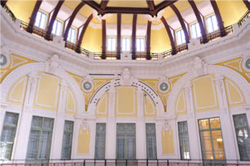
Interior of a dome in the Tokyo Station Marunouchi Building
Credit: KAZUE HASHIZUME
The bricks used were fired at different temperatures, and a mix of them was laid in each area in order for the ornamental bricks for the newly built third floor to harmonize with the existing bricks used for the first and second floors. Highly proficient workshops conducted tests and repeated a process of trial and error in order to create bricks with the same texture as that of the bricks that have survived for nearly 100 years.
In addition to such traditional techniques and construction methods, the restoration has incorporated an abundance of cutting-edge technologies. To incorporate the seismic isolation structures, for example, in which 352 earth-resistant rubber and 158 oil dampers were inserted between the area above and below ground, temporary support construction was required that entailed driving piles into the ground to support the 70,000-ton weight of the enormous station building. Such efforts contributed to making the project one of the largest ever conducted in Japan.
As for rebuilding the two domes, and although there was little in the way of blueprints or pictures of the interior to go on, the reliefs inside the domes that had been lost were nevertheless reconstructed after old documents were carefully scrutinized and upon repeated analyses and studies.
The Tokyo Station Marunouchi Building resembles stately Western architecture when viewed from the outside, but Japanese designs, such as the zodiac signs and eagles, have been used for the reliefs in the interior of the domes. One of the major appeals of Tokyo Station is that the spirit of Japan exists through such ornamentation in a Western-style building.
Tokyo Station Hotel was renovated and will reopen on October 3 along with completion of the restoration of Tokyo Station. The Hotel is based on the concept of the classic European style, and has bolstered its presence as a luxury hotel within an important cultural asset.
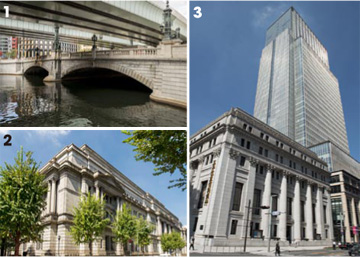
1: Nihonbashi bridge over the Nihonbashi river. The Shuto Expressway now runs above the bridge. 2: The Bank of Japan. Reservations to tour the building must be made at least a week in advance. 3: The Mitsui Main Building (left) has a number of Corinthian columns lining the exterior walls, while the interior features Doric pillars and a large-scale atrium. The high-ceilinged first (ground) floor is occupied by a bank. The eaves of the Nihonbashi Mitsui Tower (right) are elevated some 31 meters off the ground, bringing new beauty to the Nihonbashi area. Among the building's tenants are Michelin star restaurants and a luxury hotel.
Credit: MASATOSHI SAKAMOTO
The history of Nihonbashi begins in 1603 when Tokugawa Ieyasu founded the government in Edo (former name for Tokyo). The Nihonbashi bridge was constructed that year and in 1604 became the starting point for Gokaido, the five major roads that started in Edo. Soon, various types of items started arriving to the areas around Nihonbashi not just by land, but via waterways, and the area evolved into the center of commerce lined with streets of various types of stores. Also, a fish market was created at the foot of Nihonbashi and turned into a busy area bustling with people buying and selling fish.
As a result, the Nihonbashi area is still home to numerous stores that were established during the Edo period. These include Mitsukoshi, which was established in 1683 (it was initially established as a kimono store and is now a department store), Ninben (1699, known for its dried shaved bonito), Senbikiya (1834, fruit shop) and Yamamotoyama (1849, seaweed specialty store).
Incidentally, the first Nihonbashi was a wooden bridge, and burned down a number of times due to fire. The current stone bridge, which was built in 1911, was designated as an important cultural asset in 1999.
When you walk around the Nihonbashi area, you can see some historical buildings that were constructed during the Meiji period (1868–1912) and early Showa period (1926-1989). Among them is the main building of the Bank of Japan that was completed in 1896. Like Tokyo Station, this three-story stone building was designed by Kingo Tatsuno. The building retains virtually the same appearance as when it was built as it suffered very little damage from the Great Kanto Earthquake or in World War II. It was designated as an important cultural asset in 1974.
The seven-story Mitsui Building, which stands next to the Bank of Japan, was completed in 1929 and is also an important cultural asset. The building was designed by Trowbridge & Livingston, one of the three major architectural firms in New York of the time. On the seventh floor of the Mitsui Main Building is the Mitsui Memorial Museum where traditional Japanese arts and crafts, including national treasures, are on display. The entrance to the museum is an atrium (an open area with glass ceilings) that serves as the first floor of the Nihonbashi Mitsui Tower (39 stories) that was built in 2005. Here one can witness the intersection of early modern architecture and that of today.
Cool, Calm and Kichijoji
In the section of a popular Tokyo magazine's annual reader survey asking where Tokyoites would most like to live, Kichijoji regularly takes the top spot. The area is popular with people living outside Tokyo and with visitors from overseas as well. Julian Ryall enjoys a stroll around town.

A pedestrian walks past a store in Kichijoji.
Credit: ROB GILHOOLY
The area immediately around the station—which is undergoing an extensive make-over—has a maze of narrow back streets with one-off shops and restaurants, while the European-style pavement café concept has long since taken hold.
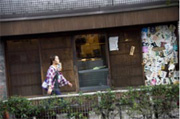
Street fashion Kichijoji style
Credit: ROB GILHOOLY
Framed pictures rest on easels outside an art gallery; a huge red daruma doll occupies pride of place in the window of a second-hand shop; the scent of German sausages sizzling on an outdoor grill wafts along the narrow street. A used-clothing store is doing a brisk trade alongside a shoe boutique, a hip hairdressers and a café-bar serving crêpes and a surprising array of international beers.
The "live house" bar and club a little further along the street will come into its own later in the evening.
Kichijoji can get crowded at the weekends, but the nearby Inokashira Park provides a green oasis in the heart of the city. There are spots in the middle of the park, amid the cherry trees, cypresses, red pines and azaleas, where the buildings of the surrounding city cannot be seen. For residents of this metropolis, the sensation is refreshing.

An artist at work alongside Inokashira Pond
Credit: ROB GILHOOLY
Looking for a meal, multicolored koi carp approach the boats with their large mouths agape while ducks preen and turtles sunbathe on the banks of the lake.
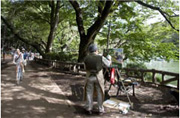
Customers unwind over food and drink at a store on the Harmonica Yokocho alley.
Credit: ROB GILHOOLY
A juggler in a bright red hat is performing in front of a crowd of appreciative children as another twists balloons into animal shapes. In the distance, a man on a keyboard is performing covers of Beatles tunes.
Amid the children on swings and slides, makeshift stalls are selling everything from hand-made jewelry, screen-printed T-shirts and glass pendants to clothing for dogs. An artist draws caricatures of a couple while alongside her, another delicately marks a henna tattoo on the back of a young woman's hand.
© 2009 Cabinet Office, Government of Japan






